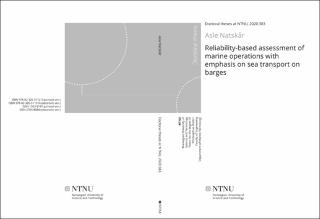| dc.contributor.advisor | Moan, Torgeir | |
| dc.contributor.advisor | Alvær, Per Øystein | |
| dc.contributor.author | Natskår, Asle | |
| dc.date.accessioned | 2020-11-13T10:49:22Z | |
| dc.date.available | 2020-11-13T10:49:22Z | |
| dc.date.issued | 2020 | |
| dc.identifier.isbn | 978-82-326-5113-9 ( | |
| dc.identifier.issn | 2703-8084 | |
| dc.identifier.uri | https://hdl.handle.net/11250/2687775 | |
| dc.description.abstract | This thesis addresses the structural reliability assessment of marine operations related to the transport of large and heavy objects. The base case has been sea transportation by means of a towed barge with an emphasis on seafastening structures, considering both weather-restricted and weatherunrestricted operations. The results are, however, generic in the sense that they are relevant for other marine operations where environmental loading governs. The reliability assessments are related to natural uncertainties and variations. Human and organizational errors are not considered. The focus is on the structural failure of the grillage and seafastening.
While the methods for structural reliability analysis are quite mature, modeling uncertainties in loads and load effects as well as the structural strength are crucial and challenging. Particular efforts are directed towards uncertainty in estimated vessel motions based on numerical and experimental investigations as well as on the uncertainty in wave conditions.
The estimated motion of the transport vessel is input to calculations of the corresponding accelerations and roll/pitch angles that are applied in calculating the load effects in the grillage and seafastening. The motion of a typical transport barge have been studied by model tests. A model of a North Sea barge at a scale of 1:50 was exposed to severe seas in regular and irregular waves. Roll damping tests were also performed. Barge models with sharp and rounded corners were tested. Based on the experiments, a model for roll damping is established. The maximum expected extreme value of the roll angle from the experiments was 22 degrees for a storm duration of three hours. The linear analyses overestimated the maximum roll angle, while the nonlinear analysis compared well.
For most marine operations, environmental loads play an important role in the design of the operation, and there will be a limit on the environmental condition in which the operation can be performed. Weather forecasts provide important information for marine operations with duration up to three days and form the basis for decision making during operations. The uncertainties in weather forecasts of the significant wave height have been studied, especially by shedding light on the approach used in practice to account for forecast uncertainty, where the so-called Alpha factor method is used. This method was implemented in the structural reliability analyses performed in this thesis and was seen to effectively compensate for the uncertainty inherent in the weather forecast. Marine operations lasting more than three days are weather-unrestricted, and the environmental conditions are based on long-term statistical data. Such data have been applied in structural reliability analyses to study variations through seasons of the year and durations of the operation. While the study of the forecast uncertainty did not reveal an abrupt change in forecast quality for lead times exceeding three days, this limitation was still used in the reliability assessment to be in compliance with current design standards.
The uncertainties in load effects and the resistance of the seafastening structure and the corresponding failure probability are estimated. The structure is assumed to be designed according to current practice, and the results provide an indication of the inherent reliability of the current practice. Moreover, the sensitivity of the reliability to environmental conditions, load effects and resistance variables is investigated.
This thesis may contribute to safer sea transport on barges by providing more knowledge on some effects that influence the structural reliability, e.g., the time of year when transport is executed and the duration of operation.
The effect has not been quantified here, but the results can provide a useful reference for future versions of design standards for marine operations. | en_US |
| dc.language.iso | eng | en_US |
| dc.publisher | NTNU | en_US |
| dc.relation.ispartofseries | Doctoral theses at NTNU;2020:383 | |
| dc.relation.haspart | Paper 1: Natskår, Asle; Steen, Sverre. Rolling of a transport barge in irregular seas, a comparison of motion analyses and model tests. Marine Systems & Ocean Technology 2013 ;Volum 8.(1) s. 5-19
https://doi.org/10.1007/BF03449266 | en_US |
| dc.relation.haspart | Paper 2: Natskår, Asle; Moan, Torgeir; Alvær, Per Ø. Uncertainty in forecasted environmental conditions for reliability analyses of marine operations. Ocean Engineering 2015 ;Volum 108. s. 636-647
https://doi.org/10.1016/j.oceaneng.2015.08.034
This is an open access article under the CC BY-NC-ND license (http://creativecommons.org/licenses/by-nc-nd/4.0/) | en_US |
| dc.relation.haspart | Paper 3:
Natskår, Asle; Moan, Torgeir.
Structural Reliability Analysis of a Seafastening Structure for Sea Transport of Heavy Objects | en_US |
| dc.title | Reliability-based assessment of marine operations with emphasis on sea transport on barges | en_US |
| dc.type | Doctoral thesis | en_US |
| dc.subject.nsi | VDP::Technology: 500::Marine technology: 580 | en_US |
| dc.subject.nsi | VDP::Technology: 500::Marine technology: 580 | en_US |

